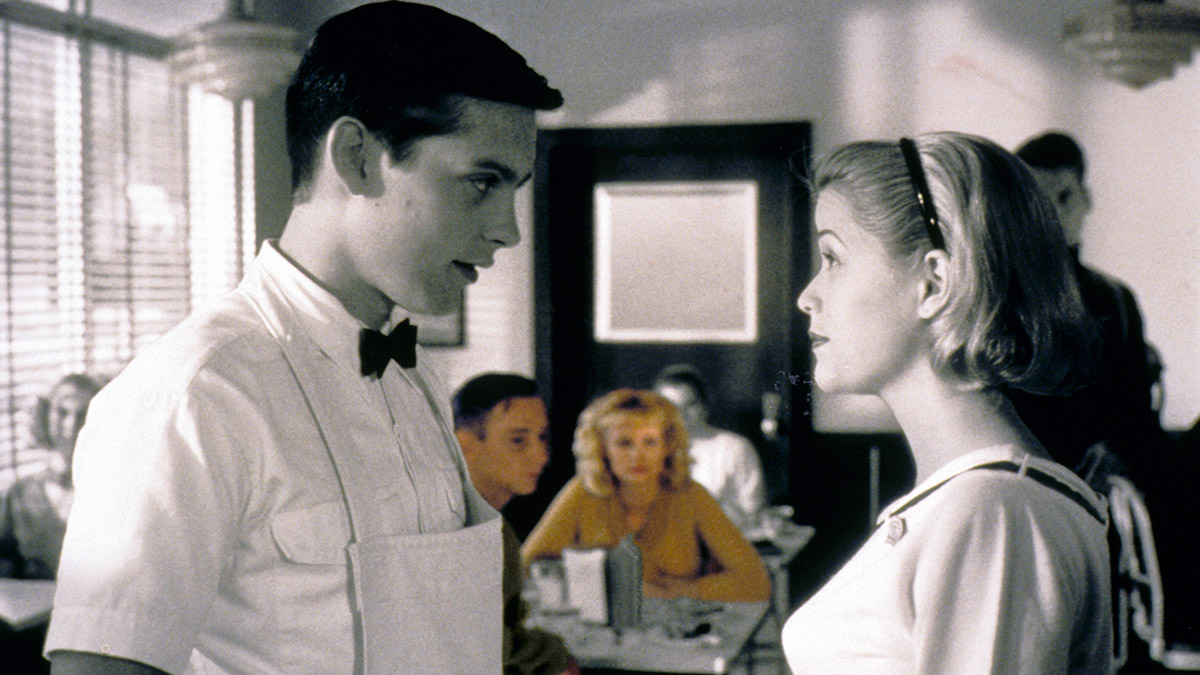
(c) Photofest / Getty Images
“Pleasantville” The division of America suggested by color techniques (Part 1)
2022.09.21
The relationship between movies and colors
There are quite a few movies that intentionally control the colors on the screen. This idea has been around since the beginning of movies.
First, there is a method called dyeing. This is a method in which the film is dipped in dye and dyed for each scene.For example, the color is dyed to match the content, such as blue for night scenes, yellow for day scenes, pink for spring when cherry blossoms are in full bloom. However, the drawback of this method was that if it was blue, it would become a monotone blue color.
A red-stained version of “Momijigari” (1899), which is said to be the oldest film shot by a Japanese person.
A technique called hand coloring (*1) was devised to bring it closer to natural full color. A specialized craftsman paints each frame with transparent paint, and depending on the method, it is possible to achieve a fairly realistic look, but it requires a large budget and specially trained personnel (mostly women). become. For example, Georges Méliès of France, known for A Voyage to the Moon (1902), also had its own coloring factory. In the United States, Edwin S. Porter of the Edison Company, Méliès's rival, created a hand-colored version of The Great Train Robbery (1903).
"Travel to the Moon" (1902), hand-colored
Hand-colored version ``The Great Train Robbery'' (1903)
This tedious work has been industrialized using the stencil method, which uses a film with holes that serve as molds for each color and prints with colored ink. This was first developed in France in 1903 with a technique called Pathécolor or Pathéchrome . However, cutting out small holes for each color is extremely difficult. The film is then enlarged and projected onto a frosted glass table, and an operator traces the outline. Then, a mechanism was developed that used a device called a pantograph, which was a drawing machine with a blade attached to it, to reduce the movement of the human hand and cut the film. A similar idea was devised in 1911 as Cinemacoloris by Segundo de Chomont, a Spaniard active in France, and adopted by Gaumont.
"Le Tour du monde d'un policier" (1906) painted with putty colors using the stencil method
(*1) At Toho, in the cultural film "Tetsudo Shingo" (39) commissioned by the Ministry of Railways, director Ikuo Oishi asked Tomio Sagisu, who was in charge of the line drawings (animation), to make the traffic lights in color. requested. When Sagisu was at a loss, his boss, Eiji Tsuburaya, suggested hand-coloring and made it happen. However, only the first print delivered to the Ministry of Railways was colored.
[References]
Written by Ushio Souji: “Dreams fly through the sky - biography of my mentor Eiji Tsuburaya” Kadokawa Shoten (2001)
(*2) In 2005, Natsuki Matsumoto, a Kyoto antique dealer and visual culture historian, discovered a 50-frame loop film that contained animation colored using the stencil method, and was called an "activity photo." A tentative title was given. Research by Dr. Frederick S. Litten, a researcher at the Bavarian State Library, revealed that it was created around 1907. This means that the birth of animation in Japan is 10 years earlier than conventional wisdom, and that it started almost at the same time as in Europe and America.
[References]
Written by Yasushi Watanabe/Natsuki Matsumoto/Frederick S. Litten/Joe Nakagawa:Nippon Anime Genesis” Shueisha (2020)

